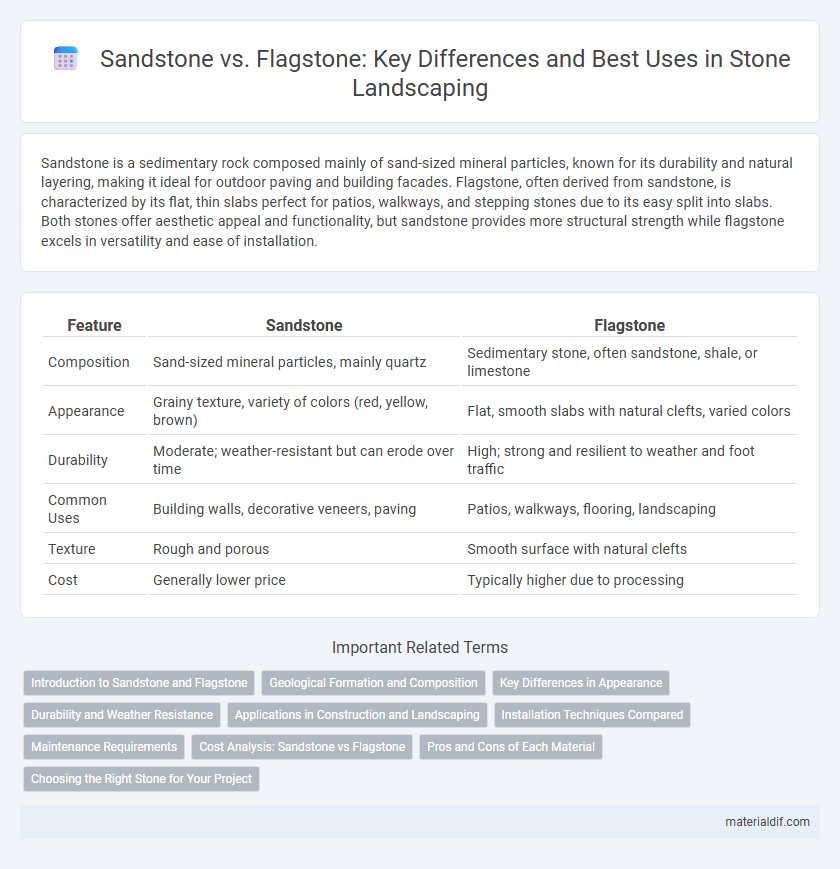Sandstone is a sedimentary rock composed mainly of sand-sized mineral particles, known for its durability and natural layering, making it ideal for outdoor paving and building facades. Flagstone, often derived from sandstone, is characterized by its flat, thin slabs perfect for patios, walkways, and stepping stones due to its easy split into slabs. Both stones offer aesthetic appeal and functionality, but sandstone provides more structural strength while flagstone excels in versatility and ease of installation.
Table of Comparison
| Feature | Sandstone | Flagstone |
|---|---|---|
| Composition | Sand-sized mineral particles, mainly quartz | Sedimentary stone, often sandstone, shale, or limestone |
| Appearance | Grainy texture, variety of colors (red, yellow, brown) | Flat, smooth slabs with natural clefts, varied colors |
| Durability | Moderate; weather-resistant but can erode over time | High; strong and resilient to weather and foot traffic |
| Common Uses | Building walls, decorative veneers, paving | Patios, walkways, flooring, landscaping |
| Texture | Rough and porous | Smooth surface with natural clefts |
| Cost | Generally lower price | Typically higher due to processing |
Introduction to Sandstone and Flagstone
Sandstone is a sedimentary rock composed mainly of sand-sized minerals or rock grains, known for its durability and warm, earthy tones. Flagstone refers to flat slabs of natural stone, often sandstone, used for paving walkways, patios, and flooring due to their broad, thin layers. Both materials offer unique textures and colors, making them popular choices in landscaping and architectural design.
Geological Formation and Composition
Sandstone forms from compacted sand grains primarily composed of quartz and feldspar through sedimentation in riverbeds or deserts, resulting in a granular texture. Flagstone is a type of sandstone characterized by its thin, flat layers formed by sedimentary processes and cemented with minerals like silica or calcium carbonate, allowing it to split into slabs. The mineral composition and layering define sandstone's durability and flagstone's natural cleft surface, making them suitable for different architectural applications.
Key Differences in Appearance
Sandstone typically features a fine-grained texture with colors ranging from tan and brown to reddish hues, giving it a warm and natural look. Flagstone presents a flat, slab-like appearance with irregular shapes and a variety of colors, including grey, red, and green, ideal for patios and walkways. The surface of sandstone is often more uniform and smooth, while flagstone's rougher texture and unique patterns provide a rustic aesthetic.
Durability and Weather Resistance
Sandstone boasts high durability due to its tightly packed quartz grains and dense composition, making it more resistant to chipping and erosion over time. Flagstone, characterized by its layered sedimentary structure, offers excellent weather resistance but can be more prone to splintering under heavy impact. In outdoor applications, sandstone outperforms flagstone in long-term durability, especially in climates with frequent freeze-thaw cycles.
Applications in Construction and Landscaping
Sandstone offers excellent durability and is commonly used in building facades, retaining walls, and paving due to its natural texture and weather resistance. Flagstone is favored for outdoor landscaping projects such as patios, walkways, and garden paths because of its thin, flat layers that create a smooth, easy-to-install surface. Both stones provide aesthetic appeal and structural integrity, with sandstone often chosen for vertical applications and flagstone for horizontal surfaces.
Installation Techniques Compared
Sandstone installation typically involves mortar beds or dry stacking, relying on its softer texture to allow easier cutting and shaping on site. Flagstone is often dry-laid with gravel or sand base, emphasizing precise leveling and tight fitting due to its harder, more uniform slabs. Both require sealing to enhance durability, but sandstone demands extra care during placement to prevent chipping and surface damage.
Maintenance Requirements
Sandstone requires regular sealing to prevent water absorption and staining, especially in high-traffic areas, while flagstone's dense composition makes it more resistant to moisture and easier to maintain without frequent sealing. Both stones benefit from routine cleaning with mild soap and water, but sandstone's softer texture demands careful handling to avoid surface erosion and scratches. Flagstone's durability results in lower maintenance costs over time, making it ideal for outdoor patios and walkways exposed to varying weather conditions.
Cost Analysis: Sandstone vs Flagstone
Sandstone generally offers a more budget-friendly option compared to flagstone, with average costs ranging from $5 to $10 per square foot, whereas flagstone typically costs between $10 and $20 per square foot due to its durability and aesthetic appeal. Installation expenses for flagstone tend to be higher because of its irregular shapes requiring skilled labor, while sandstone's uniform texture simplifies the process, reducing labor costs. Long-term maintenance costs also favor sandstone, as it is less prone to chipping and cracking than flagstone, making it a more cost-effective choice for large-scale projects.
Pros and Cons of Each Material
Sandstone offers excellent durability and a natural, earthy appearance, making it ideal for outdoor paving and landscaping, but it can be prone to erosion and requires regular sealing to maintain its integrity. Flagstone features a flat, thin profile with versatile shapes and colors, providing a slip-resistant surface suitable for patios and walkways, yet it tends to be more expensive and can crack under heavy pressure or freeze-thaw cycles. Both materials demand appropriate installation and maintenance tailored to climate conditions to maximize longevity and aesthetic appeal.
Choosing the Right Stone for Your Project
Sandstone offers durability and natural warmth, making it ideal for outdoor patios, walkways, and garden features, while flagstone's flat, smooth surface is perfect for creating sleek, modern designs and easy-to-navigate pathways. Consider the stone's hardness, thickness, and color variations to match your project's aesthetic and functional requirements. Selecting the right stone hinges on understanding the specific needs of your space, whether prioritizing slip resistance, visual appeal, or ease of installation.
Sandstone vs Flagstone Infographic

 materialdif.com
materialdif.com